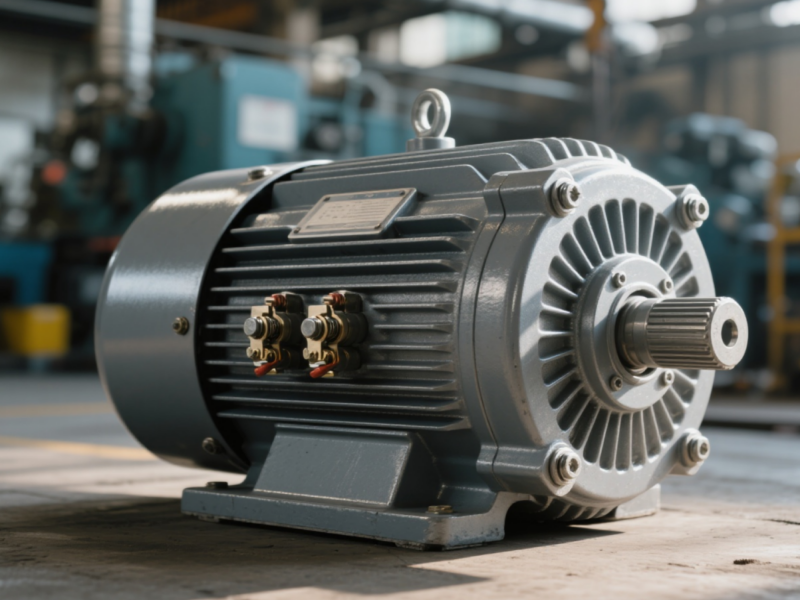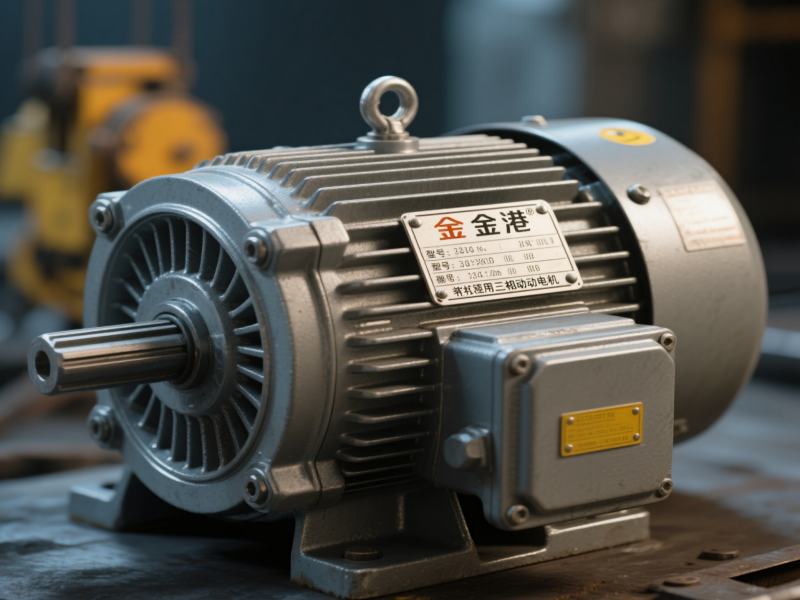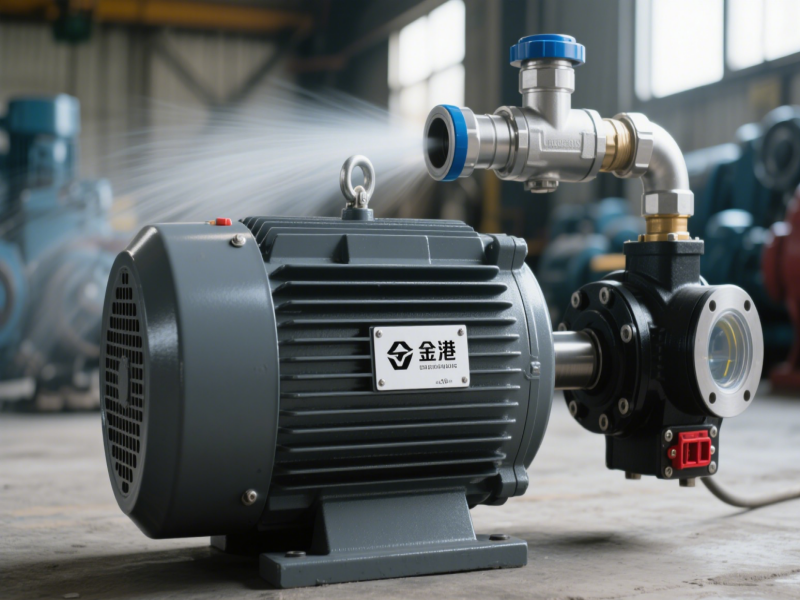Application characteristics of three-phase asynchronous crane motor
Three-phase asynchronous crane motors are special motors designed specifically for cranes (such as bridge cranes, tower cranes, gantry cranes, etc.). They need to be adapted to the crane’s core operating conditions such as “frequent starting and stopping, heavy-load starting, forward and reverse switching, and high braking requirements.”
Power Characteristics: Adapting to the Crane’s “Heavy Load + Dynamic Load” Operating Requirements.
The core functions of a crane are “lifting, luffing, slewing, and operation,” all of which must cope with heavy loads and load fluctuations. The power characteristics of a three-phase asynchronous crane motor can be precisely matched:
High starting torque ensures smooth lifting of heavy loads.
Cranes must overcome static friction and rope tension during lifting. Ordinary motors have insufficient starting torque, which can easily lead to “start-up jamming” or even failure to start. However, specialized motors, through optimized rotor resistance design and specialized stator and rotor slot configurations, can achieve starting torque multiples of 1.8 to 2.5 times the rated torque.
Wide torque range adaptability to cope with load fluctuations.
Crane loads vary during operation, such as swinging objects during lifting and load impacts caused by uneven tracks. Three-phase asynchronous crane motors offer a flatter torque-speed characteristic curve, ensuring stable torque output within the slip range. This prevents sudden speed drops or motor overloads caused by load fluctuations.
Operating Characteristics: Meeting the Crane’s High-Frequency Operation Requirements of “Frequent Starts and Stops + Forward and Reverse Rotation”
Crane operations require frequent switching between operating states, with the number of starts and stops reaching dozens or even hundreds per day. Therefore, the motor must be able to withstand these high-frequency cycles:
Highly resistant to frequent starts and stops, and boasts strong fatigue resistance.
The specialized motor utilizes high-strength insulation materials and an optimized heat dissipation structure to withstand the “winding heat accumulation” and “mechanical shock” caused by frequent starts and stops. While frequent starts and stops of ordinary motors can accelerate winding insulation aging, crane-specific motors can maintain a guaranteed service life of 5-8 years even with 100 starts and stops per day, meeting the demands of high-frequency operations in ports, workshops, and other locations.
Flexible forward and reverse switching and fast response.
Cranes require frequent forward and reverse rotation (for example, to adjust the lateral position of loads and for slewing alignment). The motor’s stator and rotor windings are designed to support fast current commutation, and the accompanying controller (such as a contactor or inverter) enables “bumpless switching.”
Braking Characteristics: Ensuring “Precise Positioning + Safety Against Falls” for Cranes
A crane’s hoisting mechanism must prevent heavy objects from falling, and its operating mechanism requires precise alignment. Braking performance is a core safety indicator. Three-phase asynchronous crane motors achieve highly reliable braking through either built-in motor braking or a matching braking device:
Built-in electromagnetic brakes provide “power-off braking.”
Most crane motors have integrated electromagnetic brakes. When the motor is powered on, the brakes release. When the power is off, a spring pushes the brake pads against the brake wheel, achieving “zero hook slip” braking. For example, when the hoist motor loses power, the brakes fully lock within 0.5 seconds. Even if the rope slackens slightly, the load will not fall, ensuring the safety of personnel and equipment. When the operating mechanism motor loses power, the brakes quickly stop the trolley/carriage, preventing misalignment due to inertia.
Supports regenerative braking and dynamic braking, suitable for high-speed load reduction.
For large-tonnage, high-speed cranes, the motor can be used in conjunction with the inverter to achieve regenerative braking or dynamic braking. This not only reduces mechanical wear during braking, but also achieves “smooth deceleration” to avoid impact caused by excessively rapid lowering of heavy objects.

Environmental Adaptability: Withstanding Crane’s Harsh Operating Environment
Crane operations often occur outdoors or in specialized workshops, subjecting them to harsh environments such as dust, humidity, high temperatures, and corrosive gases. Therefore, motors must be highly resistant to these environments:
High protection level, isolating external contaminants.
Specialized motors typically have an IP54/IP55 protection level (dustproof and splashproof). Some metallurgical crane motors can reach IP65 (dustproof and sprayproof), effectively preventing dust, rainwater, and iron filings from entering the motor interior.
High/Low Temperature Resistance Design, Suitable for Extreme Temperatures
High-Temperature Environments: The motor utilizes high-temperature-resistant insulation materials and a forced-air cooling structure, ensuring stable operation in environments between 80°C and 120°C, preventing high-temperature winding aging.
Low-Temperature Environments: The motor is equipped with a low-temperature starting aid to prevent bearing grease solidification and starting difficulties, ensuring normal starting and stopping in environments between -30°C and -10°C.
Reliability and Maintainability: Ensuring “Continuous Operation + Low Downtime Costs” for Cranes
Crane equipment is core to industrial production and logistics. Downtime directly impacts production efficiency. Therefore, motors must be highly reliable and easy to maintain:
Sturdy structure, resistant to vibration and shock.
The motor’s base and end covers are made of cast iron or cast steel, and the rotor shaft is made of high-strength alloy steel. These components withstand the vibration and shock loads of crane operation, reducing the likelihood of mechanical failure and achieving a mean time between failures of over 10,000 hours.
Easy maintenance reduces downtime.
The motor bearings utilize maintenance-free sealed bearings, eliminating the need for frequent disassembly and replacement, requiring only periodic relubrication. A built-in temperature sensor (such as a PTC thermistor) monitors the winding temperature in real time. If the temperature is too high, an alarm is triggered to prevent motor burnout and facilitate early troubleshooting. The electromagnetic brake pads utilize a quick-release design, allowing replacement without disassembling the motor. Maintenance can be performed in one to two hours, significantly reducing crane downtime costs.
Summary
The application characteristics of three-phase asynchronous crane motors are centered around the core goals of “safety, reliability, and adaptability to operating conditions.” With five key advantages: high starting torque, resistance to frequent operation, strong braking performance, wide environmental adaptability, and easy maintenance, they precisely meet the crane’s operational requirements of heavy-load lifting, frequent starts and stops, safe braking, and harsh environments. They are the core power source for all crane mechanisms (lifting, luffing, slewing, and operation), and are widely used in various crane equipment in industrial workshops, ports and terminals, construction sites, metallurgy, and chemical industries.




